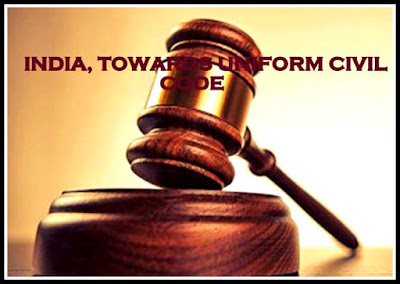INDIA, TOWARDS UNIFORM CIVIL CODE
Uniform civil code is in itself is a
debatable and controversial issue, but for me this issue is really pertinent in
today’s society. I am not writing this article for favouring or disfavouring
any section of the society, but to just through a light on “what is the
‘Uniform Civil Code’ and why it is so relevant? Does this mean imposition of
Hindu law only; will it take away the freedom of religion?; Will it hamper the
basic structure of our constitution which is prescribed under the Preamble and
under fundamental right?”
Uniform Civil Code in India is the
proposal to substitute the personal law with a comprehensive set of laws for
every citizen without distinguishing or differentiating anyone on the basis of
religion. Basically personal law deals with the issues like Marriage, Divorce, Inheritance,
Adoption and Maintenance. The idea of the Uniform Civil Code was formulated by
our constitution makers under Article 44 of the Indian Constitution and
according to this Article, “The state shall endeavour to secure for the
citizens a Uniform Civil Code throughout the territory of India”( hereinafter
referred as the UCC).
The issue which was started long back in
20th Century to provide equal rights to men and women again come
into limelight when a bench of Justices Vikramjit Sen and Shiva Kirti Singh
questioned the government about its mandate on framing the UCC. So that all the
religions are regulated by a single Law and this was happened when the bench
was hearing a petition which challenged the legal provision that compels
Christian couple to wait for at least two years for divorce, whereas this
period is one year for other religions.
When we talk about the Uniform Civil
Code, we have to consider the legal inference of UCC. First time the matter
came to public notice when the Hon’ble Supreme Court directed the parliament to
frame a UCC in the case of ‘Mohammad Ahmad Khan v. Shah Bano Begum’ in the year
1985. In this case a Muslim woman claimed for maintenance from her husband
under Section 125 of Code of Criminal Procedure after she was given talaq from
him. The Hon’ble Supreme court held that the Muslim women have the right to
maintenance under this section which is a secular legislation. While deciding
this case Chief Justice of India Y.V.CHANDRACHUD observed that “A Common Civil
Code will help the cause of national integration by removing disparate
loyalities to law which have conflicting ideologies”.
After this decision, discussion and protests
were held all over India. This decision was overturned by the then Rajiv Gandhi
government by the way of passing a legislation which is Muslim Women (Right to
protection on Divorce) Act 1986 which retrenched the right of Muslim women to
claim maintenance under Section 125 of CrPC. The second landmark case was the ‘Sarla
Mudgal v. Union of India, the question was ‘whether a Hindu husband, Married
under the Hindu Law by embracing Islam, can solemnise second marriage. The
court held that conversion to Islam and marrying again would not dissolve the
Hindu marriage under the act. Thus, second marriage which is solemnised after
converting to Islam would be an offence under Section 495(5) of Indian Penal
Code.
Some of the essentials of the UCC are
discussed below. ‘Marriage and Divorce’ under personal law contains different
essentials of a valid marriage in various religions. The new law should impose
monogamy by banning multiple marriages and the registration of marriage should
be made compulsory. This will end the discrimination against women and provides
their basic human right. The minimum age limit for male should be 21 years and
18 years for female. By formulating a common age limit, will help in curbing
child marriage. ‘Maintenance’ of women after divorce are different under Hindu
and Muslim law. Under UCC, every woman apart from belonging to nay religion
should be provided the right the right to claim maintenance under Section 125
of the CrPC. Apart from this there should be a common provision for maintenance
of mother, father, son and unmarried daughter which is prescribed under Hindu
Law. I n case of ‘Succession and Inheritence’, the situation is worst. Equal
share to son and daughter from the father’s property will end the
discrimination base on sex.
Under Article 44 of the Indian
Constitution, it is the duty of the state to implement the Uniform Civil Code
but the problem arises when people start playing communal and divisive politics.
The Supreme Court on various occasions declines to take PIL on UCC to end
discrimination against women. Hon’ble Chief Justice of India T.S. THAKUR said
that they can’t compel the government to formulate the Uniform Civil Code and
that is true to certain limits because the Courts have their own limitations.
But when Parliament is not taking the responsibility then who else will take
it. I t is also not correct that all the minorities are opposed to Uniform
Civil Code. But the government has to assure that all the minorities should be
given equal rights and opportunities and the State should protect their rights
and property, at the same time treat them equally. The UCC should be carved out
in such a way that a balance between protection of Fundamental rights and
religious dogmas of individuals be maintained.
At last, I want to conclude that India
has moved further to suvh an extent that we should be free from the religious
whims and fancies. It will help us to become Secular, where all Indians will
truly be treated equally regardless of religion. Different personal law creates
unnecessary burden on the legal system. It will also carve out the loopholes
present in different personal laws. Single personal law will also promote unity
and will help to progress India as a nation. And I must say it will help to end
vote bank politics, where there will be no way out that politicians have
anything to offer in exchange of their votes.






